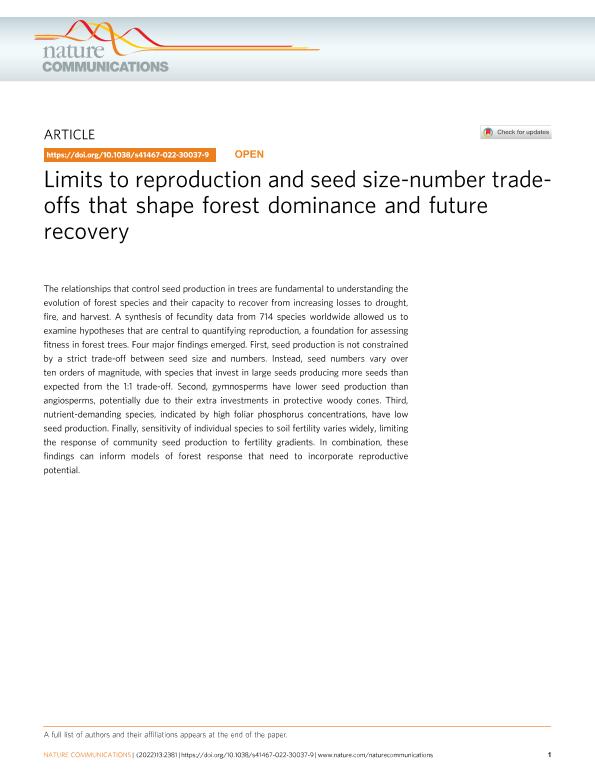Artículo
Limits to reproduction and seed size-number trade-offs that shape forest dominance and future recovery
Qiu, Tong; Andrus, Robert; Aravena, Marie Claire; Ascoli, Davide; Bergeron, Yves; Berretti, Roberta; Berveiller, Daniel; Bogdziewicz, Michal; Boivin, Thomas; Bonal, Raul; Bragg, Don C.; Caignard, Thomas; Calama, Rafael; Camarero, J. Julio; Chang Yang, Chia Hao; Cleavitt, Natalie L.; Courbaud, Benoit; Courbet, Francois; Curt, Thomas; Das, Adrian J.; Daskalakou, Evangelia; Davi, Hendrik; Delpierre, Nicolas; Delzon, Sylvain; Dietze, Michael; Donoso Calderon, Sergio; Dormont, Laurent; Espelta Morral, Josep Maria; Fahey, Timothy J.; Farfan Rios, William; Kitzberger, Thomas

Fecha de publicación:
12/2022
Editorial:
Nature
Revista:
Nature Communications
ISSN:
2041-1723
Idioma:
Inglés
Tipo de recurso:
Artículo publicado
Clasificación temática:
Resumen
The relationships that control seed production in trees are fundamental to understanding the evolution of forest species and their capacity to recover from increasing losses to drought, fire, and harvest. A synthesis of fecundity data from 714 species worldwide allowed us to examine hypotheses that are central to quantifying reproduction, a foundation for assessing fitness in forest trees. Four major findings emerged. First, seed production is not constrained by a strict trade-off between seed size and numbers. Instead, seed numbers vary over ten orders of magnitude, with species that invest in large seeds producing more seeds than expected from the 1:1 trade-off. Second, gymnosperms have lower seed production than angiosperms, potentially due to their extra investments in protective woody cones. Third, nutrient-demanding species, indicated by high foliar phosphorus concentrations, have low seed production. Finally, sensitivity of individual species to soil fertility varies widely, limiting the response of community seed production to fertility gradients. In combination, these findings can inform models of forest response that need to incorporate reproductive potential.
Palabras clave:
SEED PRODUCTION
,
TREE
,
NUTRIENTS
,
FITNESS
Archivos asociados
Licencia
Identificadores
Colecciones
Articulos(INIBIOMA)
Articulos de INST. DE INVEST.EN BIODIVERSIDAD Y MEDIOAMBIENTE
Articulos de INST. DE INVEST.EN BIODIVERSIDAD Y MEDIOAMBIENTE
Citación
Qiu, Tong; Andrus, Robert; Aravena, Marie Claire; Ascoli, Davide; Bergeron, Yves; et al.; Limits to reproduction and seed size-number trade-offs that shape forest dominance and future recovery; Nature; Nature Communications; 13; 1; 12-2022; 1-12
Compartir
Altmétricas



